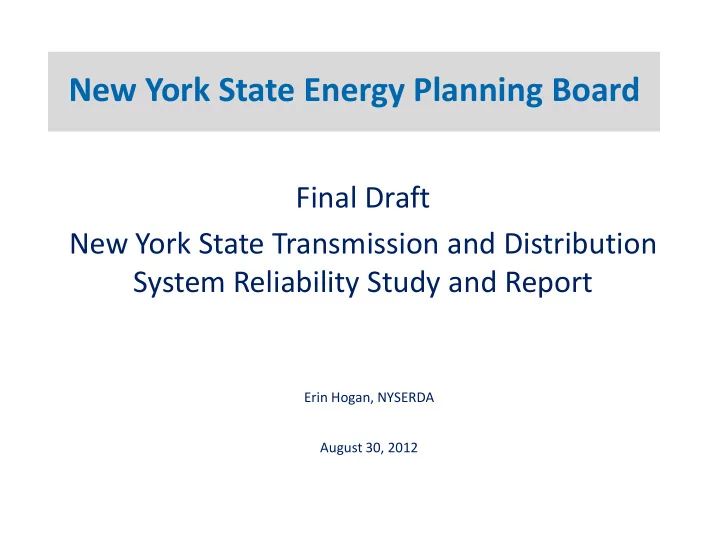

New York State Energy Planning Board Final Draft New York State Transmission and Distribution System Reliability Study and Report Erin Hogan, NYSERDA August 30, 2012
T&D Reliability Study Highlights Introduction and Overview Transmission System Reliability Distribution Reliability Investment and Expenditures Environmental Regulations T&D Reliability Impacts from Policy Future T&D Reliability Issues Key Findings and Recommendations 2 2
Overview of The Electric System
New York State High Voltage Transmission HVDC 4 4 Source: NYISO, 2012
Transmission System Reliability 5
Reliability Oversight FERC NERC NPCC NYSRC PSC Generators Transmission NYISO Other Suppliers Owners 6 6
Distribution System Reliability
Distribution Reliability Metrics Customer Average Interruption Duration Index (CAIDI) Number of Customer Hours/ Number of Customers Affected System Average Interruption Frequency Index (SAIFI) Number of Customer Affected/Number of Customers Served 8 8
Distribution Performance CAIDI for Radial and Network SAIFI for Radial and Network 12.00 1.80 1.60 10.00 1.40 8.00 1.20 1.00 6.00 0.80 4.00 0.60 0.40 2.00 0.20 0.00 0.00 2007 2008 2009 2010 2011 2007 2008 2009 2010 2011 Radial With Storms Radial W/O Storms Network Radial With Storms Radial W/O Storms Network 9 9
Investment and Expenditures
Utility Capital Expenditure ($000s) 3,000,000 2,500,000 2,000,000 Nominal $ x 1,000 1,500,000 1,000,000 500,000 0 Actual Planned 11 11 Source: DPS
Electric O&M Expenses ($000s) 1,200,000 1,000,000 800,000 Nominal $ x 1,000 600,000 400,000 200,000 0 Transmission Distribution 12 12 Source: DPS
Environmental Regulations
Environmental Regulations Existing Rules – NOx RACT Rule – Best Available Retrofit Technology (BART) Rule – Utility MACT Rule – Best Technology Available (BTA) Policy New and Future Rules – Cooling Water Intake Structures – Coal Combustion Residuals – CO 2 Emission Allowance 14
Impacts to Reliability
Reliability Impacts From Policies Load – Energy Efficiency – Large Load Growth – Other Load Varying Mechanisms Generation – Renewable Portfolio Standard – Distributed Generation Transmission & Distribution – Bulk Electric System Definition – Performance Rate Making, Multi-Year Rate Agreements, and other Departures from Traditional Regulatory Mechanisms Regulatory – Corporate Reorganization of Electric Utilities 16
Possible Future Reliability Issues Generation Transmission Load External Forces • Retirements • Aging Infrastructure • Variations • Sources • Environmental Initiatives • 2,300 miles over the next • Smart Grid and Emerging • Security Threats 10 years are nearing Technologies • Nuclear Relicensing • Geomagnetic design life • Electric Vehicles Disturbances • Market Conditions • 1,200 additional miles in • Aging Workforce next 10 to 20 years • Results • Results • Transition for both • Issues • Fuel Mix Issues/Supply • Results technology and process Diversity • Risks known and • Increases maintenance poses challenges estimated • Increases natural and downtime • Implemented correctly, gas/electric • Mitigation measures • Increases risk from new technologies could interdependence and developed unavailability optimize asset use and need for coordination • Effectiveness unknown operational efficiency 17 17
Key Findings and Recommendations As assessed using existing metrics, the electric system meets reliability standards Allow system planners and operators flexibility in their response to implement state policies Support cost-effective replacement of aging infrastructure Support diverse mix of electric generation fuel sources Monitor gas/electric interdependence Encourage workforce development Support distributed generation technologies Improve storm mitigation, restoration, and communication 18
Questions?
Recommend
More recommend